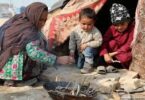MAZAR-I-SHARIF (The New York Times): A boy about 8 years old, sitting cross-legged on the cab of a truck, shouted at the top of his lungs: “Go John Cena, go boy, give it to him, I want to take all your pain on myself!”
John Cena in this case was not the American professional wrestler but a mangy, tawny shepherd dog who at that moment had his head stuck in the jaws of a rival in a blood-spattered fight, one of 13 held in a stadium on a single day late last month as part of Nowruz, or Persian New Year festivities.
John Cena shook his head free and in a frenzy ripped into his foe, a dog named German, until the judge declared a winner and their handlers pulled them apart.
Unlike dogfighting in most other countries, these matches were being held openly, with little fear of prosecution. In fact, a policeman named Ahmad Fawad was on duty, wielding a big stick in a not-always successful effort to keep the two-legged animals under control.
The venue was a public outdoor arena in the middle of Mazar-i-Sharif, a city in Afghanistan’s north; tickets were 50 afghanis each, less than a dollar. Thousands attended.
Afghan blood sports of many kinds take place unchecked, despite the opposition of mullahs who denounce them as sinful, and growing criticism from an educated younger generation that finds them the distasteful domain of warlords and their armed followers.
Afghans seem to stage fights with nearly every kind of animal: dogs, roosters, camels, canaries, finches, quails, pigeons. Although bird and dogfighting is technically illegal, fines are a modest $150 — a fraction of the sums regularly bet.
Horses used in the even more popular buzkashi matches do not fight per se, but injuries are legion as the animals bite, rear and kick, and their owners beat them and one another with whips in a sport that is a particularly vicious type of polo.
Many of these activities were on abundant display during Nowruz. For dogfighting, it is the end of the season; most matches take place during winter, as dog owners fervently believe that the cold protects their animals from their numerous wounds becoming infected.
Fighting in the heat, they say, would be inhumane.
The match at the stadium in Mazar drew dog owners from all over Afghanistan, with purses ranging from as little as $65 to more than $20,000. Usually the owners put up an agreed amount to be paid by the loser to the winner. Side bets, often considerable, are placed by spectators.
As the crowd assembled, young boys on the margins held brief practice fights with the dogs; a weak dog helps get the dominant dog in a fighting mood. Most of the fighters were large mixed breeds, some so strong they needed a halter, a leash and two men to be restrained.
Vendors circulated with trays of samosas and pastries on their heads, and relentless barking came from every corner.
Handlers washed the dogs who were about to fight, to make sure they had not been treated with pesticides or chili powders to deter dog bites.
The Nowruz crowds, and all the gambling money, don’t attract only dog owners.
WaisQasab ambled onto the stadium field with his five fighting camels, including an enormous black one, eight feet tall, who he said was his champion.
His camels get their size by breeding the male Bactrian, or two-hump camels, with female Arabian, or one-hump camels, he said. The local Bactrian males are more aggressive, the Arabians bigger, he said.
He showed off cellphone videos of past matches; the animals seem to wrestle with their long necks until one submits by running away.
“A good fighting camel can go for $200,000,” Mr. Kasab said.
Mr. Kasab never got a match, though, as his expected opponent did not show.
There was plenty of dogfighting, however, a spectacle in which the dogs’ owners are almost part of the fight themselves, slapping their dogs’ haunches and pushing them back into the fight, shouting encouragement.
The matches end when the judges decree that one of the dogs is exhibiting submissive behavior; they rarely fight to the death, in part because the winning dogs are too valuable to let them get badly injured.
TofanSatari, 18, was among the first to fight that day, and his dog Shiraz won his fifth match; he had plenty of scars to show for it.
At Mr. Satari’s home, the dog has his own room; he never plays with the children. “It wouldn’t be a good idea,” he said.
Just then a fight broke out in the stadium — between two men.
Their dogs had finished fighting and the judges had declared the tan dog, named Bee, the winner over a black dog named Leopard. His owner, Akbar, had refused to pay and was being taunted by the crowd as “Loser Akbar.” The winner, Javed, waded in and the two men traded punches.
A general melee involving hundreds ensued.
“The dogs aren’t the only animals here,” one spectator said. He declined to give his name but said he was a university student. It was his first and last dogfight, he said.
Elsewhere, such aversion is common.
A bookseller at Mazar’s Blue Mosque, Aziz Ibrahimi, said he had never attended a dogfight or a buzkashi match. “It’s inhuman, savage and hurtful to animals,” he said.
“We call ourselves a Muslim country,” he continued, “but this is not something Islam supports. The people who support such sports, they’re mostly poor and illiterate, or rich people who got their money by bad means, like the militias.”
Ismat Afghan, 21, a student, preferred the local bowling alley to the buzkashi field. “It’s not right to hurt animals like that. I don’t like it and I don’t watch it.”
The dog fighters are defensive about their pastime despite their apparent impunity. Many of them refused to allow pictures or videos to be taken by outsiders — though they take plenty of their own.
“You journalists do it and it will go on TV and they will stop these games then,” said Mohammed Alim, 30, who had come from Kunduz to see the dog fights.
After his fight, Bee was limping badly. JavedMasjidi, 33, his owner, said his dog loves to fight and is treated well, with more protein in his diet than Mr. Masjidi and his own family get. Mr. Masjidi works on a farm, where the dog is fed slaughterhouse off-cuts, as well as a liter of milk a day and half a dozen eggs; his daily training consists of four hour walks.
“Mullahs make a lot of complaints,” Mr. Masjidi said. “They call it a sin. So we just do it where they can’t see it.”
Mullah Abdul BasirBahrawi said there was little doubt that Islam forbids any game that injures or kills animals, and dogfighting in particular.
But, he asked, are matches like buzkashi, replete with injuries, any worse than cage fighting or professional wrestling in America? “After 40 years of war, lots of things are broken here,” he said.






